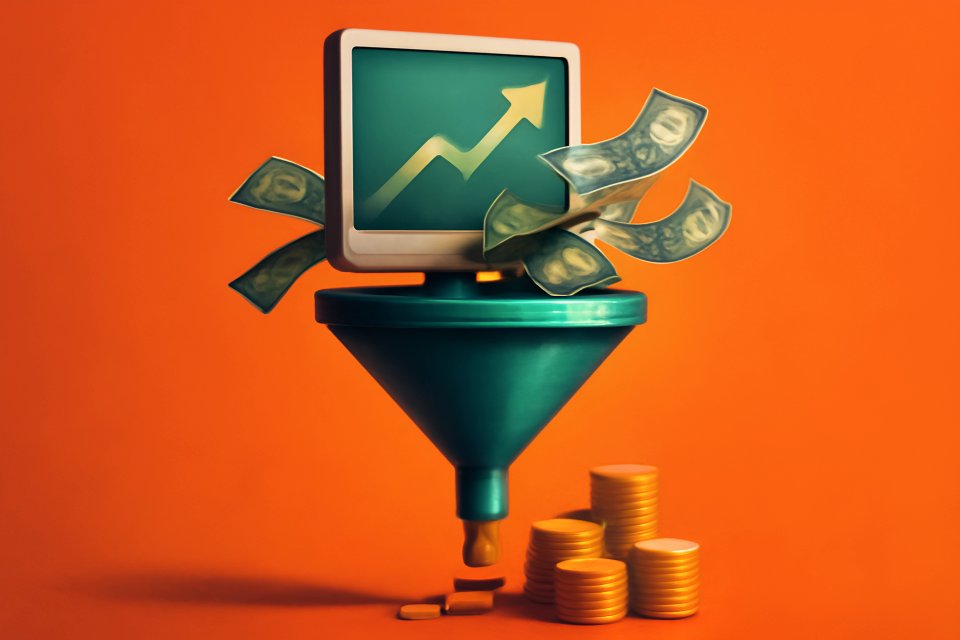
It’s 11 PM. The house is quiet, the blue light of your laptop screen is the only thing illuminating the room, and a notification pops up: “Payment Received.” A jolt of pure adrenaline hits you. It’s working. This thing you’ve been building in the stolen hours—the early mornings, the late nights, the weekends—is actually making real money. And then, the dangerous, thrilling question whispers in your mind: Could I actually do this full-time?
That question is where the dream of quitting your 9-to-5 is born. But it’s also where a paralyzing fear takes root. The gap between a profitable side hustle and a sustainable full-time business feels like a chasm. It’s not just about having more hours in the day; it’s a fundamental shift in who you are, how you think, and how you operate.
This is not another guide telling you to “just take the leap.” This is your roadmap for building a bridge, plank by plank, over that chasm. We will provide the actionable, no-hype blueprint for making the transition from a side hustle to a full-time freelance career. We’re moving beyond simply earning more to focus on building a resilient digital business, covering the financial, operational, and mental steps required for your long-term survival and success.
The Mindset Upgrade: Thinking Like a CEO, Not a Hustler
The first and most critical step in this journey has nothing to do with your skills or your client list. It happens entirely between your ears. You must stop thinking like someone who does tasks and start thinking like someone who runs a business.
From Task-Doer to Business Owner
A hustler reacts, chasing the next gig and the next invoice. A CEO anticipates, building systems for marketing, sales, and client delivery. This is the core difference that separates freelancers who burn out from those who build empires. According to The Interview Guys, with 64 million Americans now freelancing, this is no longer an alternative path; it's a major economic force, and it demands a professional mindset.
To make this shift tangible, you must schedule a non-negotiable, weekly “CEO Hour.” This is your time to work on the business, not just in it. During this hour, you review your finances, plan your marketing activities, and refine your processes—the high-level strategic work that a hustler always pushes aside for "billable" tasks.
This scheduled time is your commitment to building a real company, not just a series of freelance jobs. It’s the single most powerful habit you can build to ensure your freelance career transition is built on a foundation of strategy, not just effort. It’s the difference between being a busy freelancer and a profitable business owner.
Conquering the "Stability Myth" and Imposter Syndrome
The fear of losing a steady paycheck is primal. It’s a fear of losing security, of not being able to provide for yourself and your family. But the "stability" of a traditional job is often an illusion; you are always one reorganization or one bad quarter away from being let go. True stability comes from control, and as a freelancer, you are in control.
You build that control and conquer imposter syndrome with proof. Start by systematically collecting testimonials and case studies from every successful project. Then, move beyond tracking just your income and start monitoring key business metrics like Client Lifetime Value (CLV) and Profit Margin. These numbers are undeniable evidence of the value you create.
This data-backed confidence is reflected across the industry. A comprehensive report on the state of freelance work found that only 7% of freelancers plan to return to traditional employment, showing immense confidence in freelancing as a sustainable career. Your professional online presence, your tracked metrics, and your glowing testimonials are your armor against doubt.
Setting Boundaries for a Sustainable Career
The "hustle 24/7" mentality that got your side gig off the ground will destroy you as a full-time business owner. Burnout is the silent killer of freelance dreams. You are not a machine, and your creativity and problem-solving skills—the very things clients pay you for—require rest to function at a high level.
The solution is to create and enforce ruthless boundaries from day one. Define your official work hours and communicate them clearly in your email signature and client onboarding documents. Create a dedicated workspace, even if it’s just a corner of a room, to signal to your brain when it’s time to work and when it’s time to switch off.
These boundaries are not for your clients; they are for you. They protect your mental health, preserve your energy, and ultimately make you a better, more focused freelancer. Data from Website Planet shows that 77% of full-time freelancers report a better work-life balance, but this outcome is not an accident—it is the direct result of intentional, disciplined boundary-setting.
The Financial Litmus Test: Are You Financially Ready to Leap?
Hope is not a financial strategy. Before you even think about handing in your notice, you need to look at the cold, hard numbers. This is the no-hype reality check that will determine if your dream is a viable business plan or a reckless gamble.
Calculate Your "Freedom Number"
Your "Freedom Number" is the absolute minimum monthly income your business needs to generate to cover all your expenses and be profitable. It’s not your current salary; it’s a new number built from the ground up. You must calculate it with brutal honesty.
Here is the simple formula:
(Monthly Personal Expenses) + (Monthly Business Expenses) + (Monthly Tax Savings) + (Monthly Profit/Savings) = Your Freedom NumberDon't forget the freelancer's surprise: taxes! You need to set aside roughly 25-30% of every single payment for taxes. And yes, you must include profit. A business that only breaks even is not a business; it's a high-stress hobby.
This number transforms your goal from a vague "I want to go full-time" into a concrete, measurable target. It removes emotion from the equation and gives you a clear benchmark for success. As Solowise points out, with nearly half of global workers being self-employed, mastering your finances is a non-negotiable skill for modern professionals.
Building Your Financial Runway
Once you know your Freedom Number, you need to build a financial runway. This is an emergency fund specifically for your business, covering 3-6 months of your total expenses (your Freedom Number multiplied by 3-6). This is your safety net, your confidence booster, and your most powerful negotiation tool.
This runway is what gives you the power to walk away from low-paying, soul-crushing projects. It allows you to be selective, to only take on work that aligns with your goals and expertise. Without it, you'll be forced to make decisions out of desperation, which is the fastest way to resent the freedom you worked so hard to create.
Think of this fund as a strategic investment in your own peace of mind. It’s the buffer that allows you to handle a slow month, a difficult client, or an unexpected expense without panicking. It is the financial foundation upon which a resilient freelance business is built.
Stress-Test Your Side Hustle Income
Here is the final test. Before you quit your day job, you must prove that your side hustle can consistently generate your Freedom Number for at least 3-6 consecutive months. This is the ultimate validation of your business model.
This isn't just about hitting a financial target. It's about proving that your client acquisition and cash flow systems are reliable and repeatable. Can you consistently find and close new clients? Do you have a process for invoicing and getting paid on time?
Successfully passing this stress test removes the "leap of faith" from the equation. You are no longer jumping into the unknown. You are taking a calculated, confident step onto a foundation that you have already proven can support you.
The Productivity Engine: Systems for Scaling Your Side Hustle
The ad-hoc methods you used to manage one or two side clients will crumble when you have five or ten full-time clients. To succeed, you need to build a productivity engine—a set of systems and tools that automate the mundane, streamline your workflow, and free you up to do your best work.
Ditching the Chaos: Your Central Command Center
Your brain is for having ideas, not for holding them. As your client load grows, you need a central command center to manage projects, tasks, and deadlines. A robust project management system is the digital headquarters for your entire business operation.
For visual thinkers, a tool like Trello offers simple, card-based boards. For those who need more structure, Asana provides task-driven workflows. And for an all-in-one solution, Notion can serve as your project manager, CRM, and knowledge base.
The specific tool matters less than the habit of using it consistently. A central system prevents things from falling through the cracks, reduces your mental load, and presents a polished, professional image to your clients. This is a core component of building an efficient productivity system for solopreneurs.
Automate to Accelerate: Reclaiming Your Time
As a business owner, your time is your most valuable asset. Every minute you spend on low-value administrative tasks is a minute you aren't earning money or growing your business. The solution is to automate everything you possibly can.
Start with the biggest time-sinks. Use a tool like Calendly to eliminate the endless back-and-forth of scheduling meetings. Implement an invoicing system like Wave or FreshBooks to automate payment reminders. For a truly seamless experience, a client management platform like Dubsado or HoneyBook can automate your entire onboarding process, from contracts to questionnaires to the initial invoice.
This isn't about being lazy; it's about being strategic. By hiring these "digital assistants," you build a scalable business that can handle growth without requiring you to work more hours. You can explore a full suite of options in our guide to the ultimate digital tools stack for solopreneurs.
Designing Your Ideal Workday
The absolute freedom of a full-time freelance schedule is both a blessing and a curse. Without the structure of a 9-to-5, it's easy to fall into reactive, unproductive patterns. You must become the architect of your own ideal workday.
Embrace powerful techniques like time-blocking, where you schedule specific blocks of time for different types of work—deep work on client projects, marketing and outreach, and your weekly CEO Hour. This proactive approach ensures you are dedicating your best energy to your most important tasks, rather than just reacting to your inbox. According to Website Planet, most freelancers work hours comparable to full-time employees, and this level of intentional structure is what makes those hours count.
A well-designed day provides the structure you need to be consistently productive. It allows you to harness your newfound freedom for maximum output and minimal stress. Mastering these techniques is essential for achieving productivity mastery for solopreneurs.
The Growth Blueprint: Building a Resilient Client Pipeline
Once you've made the leap, your focus must shift from short-term survival to long-term, sustainable growth. A resilient business isn't built on luck; it's built on a strategic plan for attracting and retaining high-quality clients. This is how you achieve true digital career growth.
Diversify Your Offerings to Create Stability
Relying on a single large client is one of the most dangerous positions for a freelancer. If that client leaves, your entire income disappears overnight. The key to long-term stability is diversification.
Move beyond selling just your time. Create productized services, which are fixed-scope, fixed-price packages like a "Website SEO Audit" or a "Brand Logo Package." You can also develop digital products like e-books or templates that generate passive income. Adding consulting or coaching calls provides another high-value revenue stream.
This strategy transforms you from a simple service provider into a multifaceted business. It creates multiple streams of income that insulate you from the volatility of client work. This is the first step in turning your freelance practice into a scalable online business, a concept we explore further in our Freelance to Empire guide.
Create a Simple, Repeatable Marketing System
The dreaded "feast or famine" cycle is a direct result of inconsistent marketing. To create a predictable flow of leads, you need a simple, repeatable marketing system that you can execute consistently, even when you're busy with client work.
Don't try to be everywhere at once. Choose ONE primary marketing channel and commit to mastering it. Whether it's creating valuable content on LinkedIn, writing for a niche blog, or engaging in highly targeted email outreach, the key is consistency over complexity.
A simple system that you execute daily is infinitely more powerful than a complex strategy that you never implement. With the freelance market projected to surpass $500 billion by 2025, a consistent marketing effort is all it takes to carve out your piece of this massive opportunity. You can even explore emerging freelance platforms to diversify your lead sources.
The Art of Raising Your Rates (Because You're a Pro Now)
The rates you charged as a side hustler are no longer relevant. You are now a full-time professional with overhead, taxes, and the need to generate a profit. Your pricing must evolve to reflect your new reality and your growing expertise.
Frame rate increases as a natural and necessary part of your business growth. For existing clients, provide ample notice and clearly communicate the increased value you now provide. For all new clients, start immediately with your higher, professional rates—no exceptions.
Raising your rates does more than just increase your income. It acts as a filter, attracting more serious, higher-quality clients who respect your value. It is a powerful statement about your confidence and your commitment to running a professional, sustainable business.
Your Journey Starts Now
Making the transition from a side hustle to a full-time digital career is one of the most empowering journeys you can take. It’s not about a single, risky leap of faith. It’s about the deliberate, strategic process of building a bridge to your future, piece by piece.
You do this by upgrading your mindset from hustler to CEO. You validate your readiness with a cold, hard financial litmus test. You build scalable productivity systems to handle growth, and you design a resilient marketing blueprint to ensure your client pipeline never runs dry.
Financial freedom is not a lottery ticket; it is a skill. It is a muscle you build through smart, sustainable habits. The power to create the career and life you want is entirely in your hands.
What is the #1 action you'll take this week to prepare for your full-time freelance transition? Share your commitment in the comments below.














